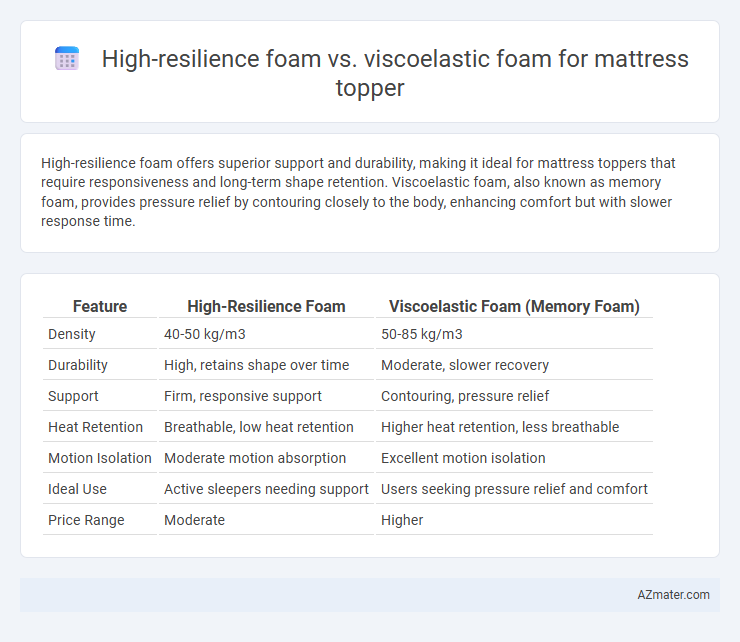High-resilience foam offers superior support and durability, making it ideal for mattress toppers that require responsiveness and long-term shape retention. Viscoelastic foam, also known as memory foam, provides pressure relief by contouring closely to the body, enhancing comfort but with slower response time.
Table of Comparison
| Feature | High-Resilience Foam | Viscoelastic Foam (Memory Foam) |
|---|---|---|
| Density | 40-50 kg/m3 | 50-85 kg/m3 |
| Durability | High, retains shape over time | Moderate, slower recovery |
| Support | Firm, responsive support | Contouring, pressure relief |
| Heat Retention | Breathable, low heat retention | Higher heat retention, less breathable |
| Motion Isolation | Moderate motion absorption | Excellent motion isolation |
| Ideal Use | Active sleepers needing support | Users seeking pressure relief and comfort |
| Price Range | Moderate | Higher |
Introduction to Mattress Topper Foam Types
High-resilience foam offers superior support and durability with its open-cell structure, promoting airflow and quick responsiveness to body movements. Viscoelastic foam, commonly known as memory foam, provides exceptional pressure relief by contouring closely to the body's shape and reducing motion transfer. Choosing between these mattress topper foams depends on desired comfort, support level, and temperature regulation needs.
What is High-Resilience (HR) Foam?
High-Resilience (HR) foam is a high-density polyurethane foam known for its durability, excellent support, and responsiveness, making it ideal for mattress toppers that require long-lasting comfort. It quickly adapts to body movements, providing consistent pressure relief and enhanced bounce compared to viscoelastic foam. Unlike viscoelastic foam, which has a slow response and heat retention, HR foam promotes better airflow and cooling while maintaining firm support.
What is Viscoelastic (Memory) Foam?
Viscoelastic foam, commonly known as memory foam, is a temperature-sensitive material that contours precisely to body shape, providing exceptional pressure relief and support by evenly distributing weight. Unlike high-resilience foam, which offers a firmer and more buoyant surface with faster response to movements, viscoelastic foam slowly returns to its original shape, enhancing comfort by reducing motion transfer. Its viscoelastic properties make memory foam ideal for mattress toppers aimed at alleviating pressure points and improving spinal alignment.
Support and Pressure Relief Comparison
High-resilience foam offers robust support with its responsive, durable structure that maintains shape and provides consistent spinal alignment, ideal for individuals needing firm support. Viscoelastic foam, known as memory foam, excels in pressure relief by contouring closely to the body's curves, distributing weight evenly and minimizing pressure points. Mattress toppers made from high-resilience foam suit those preferring a bouncy feel and strong support, while viscoelastic foam toppers benefit sleepers seeking enhanced pressure alleviation and personalized comfort.
Comfort and Sleeping Experience
High-resilience foam offers superior support and durability, adapting quickly to body movements and providing a buoyant sleeping surface that maintains spinal alignment. Viscoelastic foam, commonly known as memory foam, excels in pressure relief by contouring precisely to body shape and reducing motion transfer for a more restful sleep. Choosing between the two depends on whether you prefer a more responsive, supportive feel or the deep contouring, cradle-like comfort characteristic of viscoelastic foam.
Durability and Longevity
High-resilience foam offers superior durability with its open-cell structure that quickly regains shape and resists sagging, making it ideal for long-lasting mattress toppers. In contrast, viscoelastic foam, also known as memory foam, provides excellent pressure relief but tends to lose firmness and deteriorate faster under prolonged use. Choosing high-resilience foam for mattress toppers ensures extended lifespan and consistent support over time.
Temperature Regulation and Breathability
High-resilience foam offers superior breathability and temperature regulation due to its open-cell structure, allowing increased airflow and heat dissipation. Viscoelastic foam, commonly known as memory foam, tends to retain heat because of its dense composition, which limits ventilation and traps body heat. For those prioritizing cooler sleep and enhanced airflow, high-resilience foam mattress toppers provide a more effective solution in managing temperature and moisture.
Allergy Resistance and Health Aspects
High-resilience foam offers excellent allergy resistance due to its dense structure, which inhibits dust mites and allergens, making it suitable for individuals with asthma or allergies. Viscoelastic foam, also known as memory foam, provides pressure relief but can retain heat and moisture, potentially promoting dust mite growth if not properly ventilated. Both foams benefit from antimicrobial treatments, but high-resilience foam generally requires less maintenance to maintain health-friendly sleep conditions.
Price and Value Considerations
High-resilience foam mattress toppers generally offer superior durability and bounce at a lower price point, making them a cost-effective option for long-term use. Viscoelastic foam, known as memory foam, often comes at a higher cost due to its pressure-relieving properties and body contouring comfort, providing greater value for those prioritizing pain relief and support. Choosing between the two depends on budget constraints and whether the primary value lies in longevity and resilience or enhanced comfort and pressure distribution.
Which Foam is Best for Your Mattress Topper?
High-resilience foam offers superior support and durability, making it ideal for those seeking long-lasting firmness and enhanced spinal alignment in a mattress topper. Viscoelastic foam, also known as memory foam, excels at contouring to body shape, providing pressure relief and reducing motion transfer for a more comfortable sleep experience. Choosing between the two depends on your preference for either robust support with quick recovery (high-resilience) or personalized comfort with pressure alleviation (viscoelastic).

Infographic: High-resilience foam vs Viscoelastic foam for Mattress topper
 azmater.com
azmater.com